Cold, rain, snow, sleet, and wind may not delay the mail but they can sure delay the meal. When the exterior of your grill or smoker is cold the interior is not happy. The cold metal absorbs heat from the warm air inside lowering the cooking temp. Whether you are using gas, charcoal, or pellets, in inclement weather you need to be sure to preheat your cooker until the metal is too hot to touch and you need more fuel to heat the air and the walls of the cooking chamber initially and throughout the whole cook. Also, because the combustion process needs oxygen, it sucks in cold air and that can further reduce the oven temp. Meanwhile, moisture from the meat and water pans condenses on the interior like fog on the bathroom mirror further cooling the metal.
On thin walled metal machines like the Weber Kettle or the Weber Smokey Mountain, and even thick metal pits like the Horizon offsets, unless you add more fuel, you will be late serving dinner. If you serve at all. On insulated devices like ceramic kamados or Backwoods Smokers, you’ll use a lot of fuel and time getting it up to target temp, but once you get there maintaining it is less of a problem, although they will need more fuel.
Gas cookers
Many people erroneously believe that gas will not flow at low temperatures. Not true. Propane is in liquid form in the tank, and it must boil to become a gas. The boiling point of propane is -44°F so you should have no problem getting gas to flow unless you live in Siberia. The pressure will drop as the air temp drops, and as the level of fuel drops, but that’s why gas grills and smokers have a regulator, that disk-shaped device between the tank and the cooker. It regulates the flow to keep it even. According to the AmazingRibs.com science advisor Prof. Greg Blonder, “Tank pressure never drops below the regulator pressure, so gas should flow just fine. Water vapor is sometimes in the tank and it may freeze and gum up the valves, but this is rare. If you have a large device with a red colored regulator, like a turkey fryer, the pressure may be inadequate.”
Also, since nothing is simple in this world, some propane is blended with small amounts of butane to improve ignition. Butane gasifies at 33°F. So the actual boiling point depends on the blend. In real world applications, it doesn’t make much of a difference, but if you are working in a really cold climate, this table might come in handy.
Because it takes more fuel to heat your gasser in winter, you may find it doesn’t get as hot as it does in warm weather and you will find that you use more gas than in summer. You will also use more fuel because some BTUs are wasted getting the liquid to a gaseous state. One antidote is to use a larger tank on small portables, and use full tanks that have higher pressure on larger grills.
If you are using natural gas, the fuel should be coming from the warm house, and even the cold fuel in the outdoor pipes will flow with no problem, propelled by the warm fuel behind it.
Charcoal and pellets
With charcoal and pellet burners, you will go through more fuel heating the cooking chamber and the metal. So be prepared and light more fuel than you usually do. If you normally use the Minion or snake methods, you might want to skip them and just light the whole firebox. As usual, there’s no substitute for experience, so doing a dry run without food makes a lot of sense. Master your instrument!
Some remedies
While we have proven that opening the lid to peek during warm weather has little impact on cooking time in warm weather, in cold weather it has a more profound impact, so keep the lid closed and the warm air in, although the temp does recover pretty quickly once you close the lid. If there’s room, try putting bricks in the cooking chamber to absorb and radiate heat. This is especially useful on offset smokers, and I recommend it year-round.
The simplest solution is to place your cooker where it won’t get hit with wind and rain, but of course you want to be careful not to melt your vinyl siding or set the eaves ablaze. Never move a grill or smoker indoors. And that means your garage. Carbon monoxide can collect in there, and in an attached garage the home’s heating system can easily suck this deadly gas into the house and into your kids’ bedrooms.
The Cold Weather Jacket is silicone coated jacket is designed to insulate your 22.5″ Weber Smokey Mountain while cooking and it can easily be adapted for a Weber Kettle. Silicone coated, it is great for use in cool, rainy, and windy conditions or as as a weather cover while not using your cooker. It has a flap that opens for reading the temperature indicator, grasping the handle, and adjusting the exhaust vent, and another flap through which you can attach a thermostat controller.
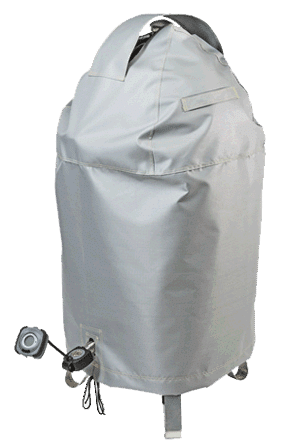
My friend John Dawson of PatioDaddioBBQ.com says, “A quick, easy, cheap, and effective shelter for small vertical cooker is a simple wardrobe-style packing box like you use for moving.” That’s great as long as the wind doesn’t pick up. He also offers this advice: “Treat your cooker like you treat yourself when it’s cold. Keep it dry, keep it out of the wind, insulate, and take in more calories (fuel and oxygen).”
Another good solution is to wrap the cooking chamber in a welding blanket. They’re good wind, rain, and snow protection and can handle the heat without bursting into flame. They can probably handle the heat of the firebox, but I wouldn’t press your luck. Reflectix Double Foil Insulation works well for cooking chamber insulation. It has a bubble-wrap type interior clad in a foil sheathing. It is heat resistant, but it can melt if things get too hot, so use it only around the cooking chamber. Don’t put it in direct contact with the firebox portion of your cooker. Foil insulation mat works well, too.
With any of these insulators, it is important that you allow proper airflow. If you slow or block oxygen in and smoke out, you can end up starving the fire and extinguishing it or produce gray smoke and soot that can foul the food.
I asked my Facebook friends to send me pix of how they solved the problem and I got some great responses. Several use fiberglass insulation with foil backing or hot water heater blankets but I am concerned that they could burn or melt if things get too hot. If you go this route, you should only wrap the food chamber and keep the insulation from making contact with the hot parts of the cooker. Below are some of the other clever solutions hungry readers have devised to keep their babies warm and happy. My favorite is “Ft. Smokey” built by Brian Romick, at the top of the page.
Mike Schultz built his 18.5″ WSM a hut. “It works great, keeps it out of the wind when smoking and covered to keep out the elements.”

Jessica Loula Parthun “Built this with plywood and some heavy duty hinges and wrapped it in flexible insulation. The weight keeps it from blowing over and the size can be adjusted due to the hinges. I can pull it close to the smoker or fan it out dependent on the weather. Works great!”
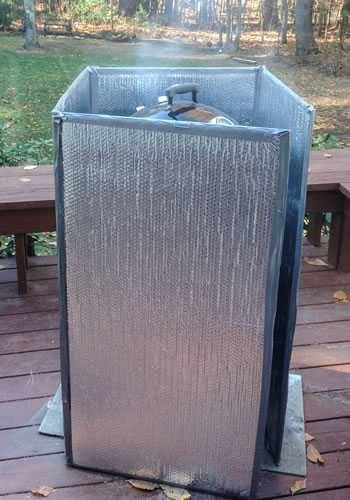
Jim Streisand built a wind shield with an old dog crate as a frame for foil insulation.
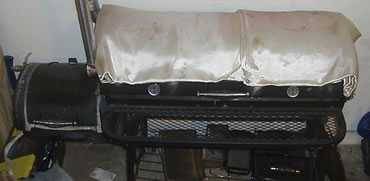
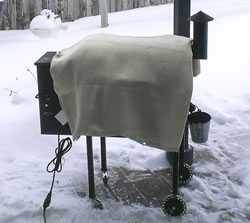
Jerod Broussard uses a welding blanket over the cooking chamber, not the firebox (above). “I folded it over on itself and secured it somewhat with small wires so it doesn’t fall off when I open the lid. Some readjustment is necessary. With a smoker temp of over 300°F I can still place my hand firmly on the blanket for extended periods of time.”
Richard Meisinger Jr. uses a welding blanket on his Traeger, above right.
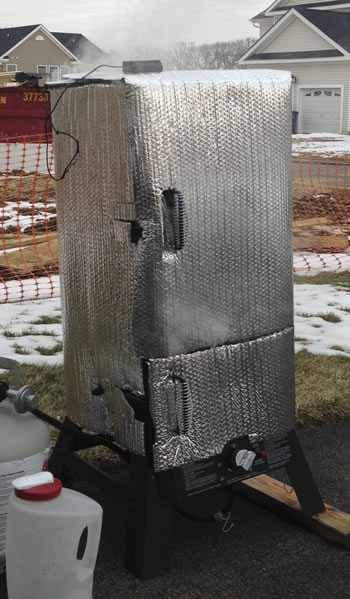
Naor Chazan “Used a box cutter to cut out room for handles, doors, and vents, then just roll on using those 3M stick-on velcro tabs to make this thing a convertible. I think the heat rating is something like 250 but that is from direct heat. Since this smoker’s exterior is warm to the touch (when smoking ~225), I’m not too concerned with it.”
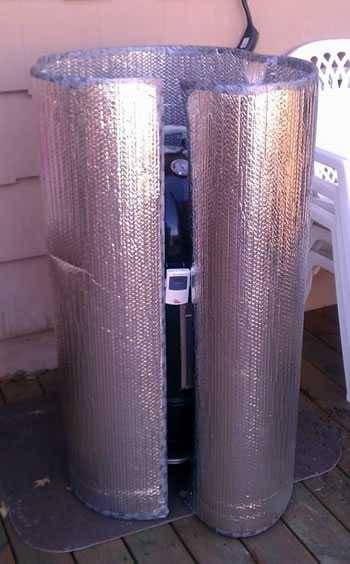
Randell Hilton simply wraps his WSM with a hot water heater insulator.
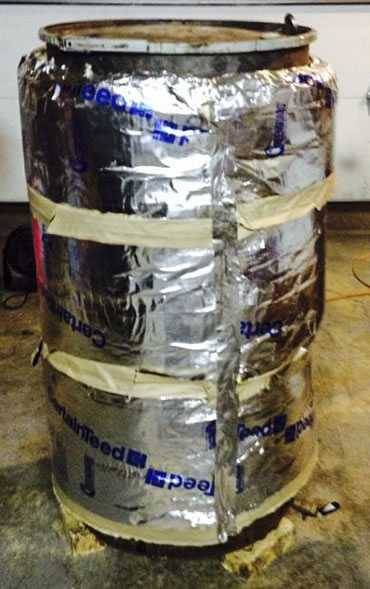
Jerry Becker “Here’s what I use on my [Ugly Drum Smoker]. I smoke at -20°F and EASILY maintain 250°F for hours on minimal fuel. Easy and cheap.”

Mike Palouian said “I live in the Northeast. My pop up tent’s back legs buckled and broke [from] holding a load of snow. The way it fell over couldn’t have worked any other way. My electric MasterBuilt smokers have stayed dry since November.”

Chris Shore’s blanket
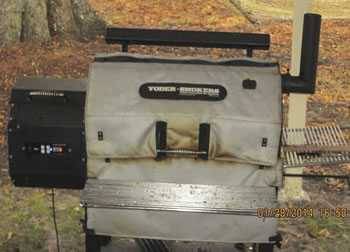
Sammy J Shuford says “I have Yoder YS640 I bought used, came with the yoder blanket. Makes a huge difference in pellet consumption.”

Mike McKiernan simply shields his smoker with plywood. “It’s not very attractive but it’s effective. I’ve smoked pork shoulder for 13 hrs & 45 minutes with ambient temperatures from 17 to 25F.”

Thomas Uhlin uses a steel-worker’s coat to block the wind.
Grillin’ in the Snow
By Meathead
To the tune of “Singin’ in the Rain” with apologies to Gene Kelly
I’m grillin’ in the snow,
Just grillin’ in the snow!
What a glorious feelin’,
I’m chillin’ doncha know.
I’m laughing at snow
Meltin’ in the glow.
The grill is not fazed,
The meat’s ready for glaze.
Let the stormy clouds chase
Everyone from the place,
Come on with the flakes,
I’ve a smile on my face.
I walk out the door,
With a hunger for pork,
Flippin’ the meat,
I’m ready to eat.
[Dance] Grillin’ in the snow
Dee-ah dee-ah dee-ah
Dee-ah dee-ah dee-ah
I’m chillin’ doncha know!
I’m grillin’ and chillin’ in the snow!




High quality websites are expensive to run. If you help us, we’ll pay you back bigtime with an ad-free experience and a lot of freebies!
Millions come to AmazingRibs.com every month for high quality tested recipes, tips on technique, science, mythbusting, product reviews, and inspiration. But it is expensive to run a website with more than 2,000 pages and we don’t have a big corporate partner to subsidize us.
Our most important source of sustenance is people who join our Pitmaster Club. But please don’t think of it as a donation. Members get MANY great benefits. We block all third-party ads, we give members free ebooks, magazines, interviews, webinars, more recipes, a monthly sweepstakes with prizes worth up to $2,000, discounts on products, and best of all a community of like-minded cooks free of flame wars. Click below to see all the benefits, take a free 30 day trial, and help keep this site alive.
Post comments and questions below
1) Please try the search box at the top of every page before you ask for help.
2) Try to post your question to the appropriate page.
3) Tell us everything we need to know to help such as the type of cooker and thermometer. Dial thermometers are often off by as much as 50°F so if you are not using a good digital thermometer we probably can’t help you with time and temp questions. Please read this article about thermometers.
4) If you are a member of the Pitmaster Club, your comments login is probably different.
5) Posts with links in them may not appear immediately.
Moderators